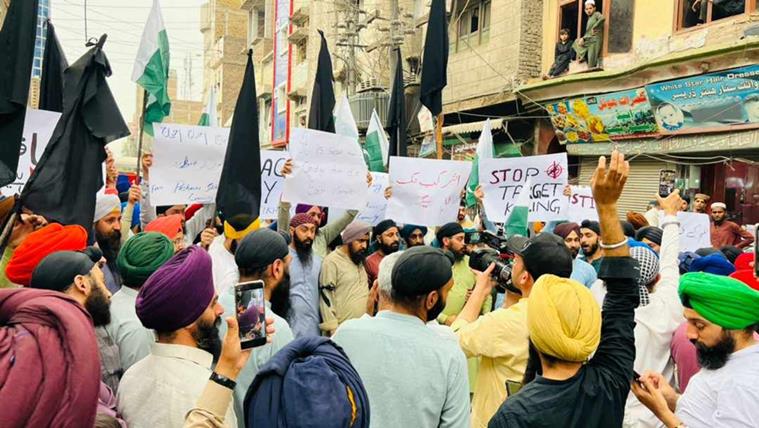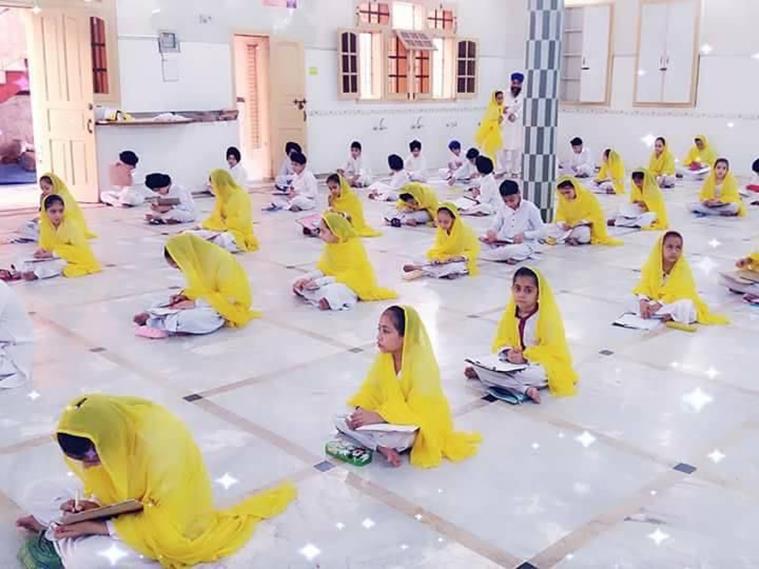
The Sikhs in the Pashtun majority Khyber Pakhtunkhwa province trace their roots to the times when this entire region was part of Afghanistan. It was only in 1834 that Hari Singh Nalwa, one of the bravest generals in the Army of Maharaja Ranjit Singh, annexed Peshawar from Afghan rulers and made it a part of the undivided Punjab. During the British rule, Peshawar and other north-western districts of Punjab were made a separate province called North-Western Frontier Province (NWFP). After the partition in 1947, NWFP went to Pakistan with Peshawar as its capital city.
The NWFP province was renamed as ‘Khyber Pakhtunkhwa’ on the demand of Pashto language speaking ‘Pakhtun’ population by the government of Pakistan in 2010, to protect their unique identity just like Punjab for Punjabis, Sindh for Sindhis and Balochistan for Balochis. It is due to the proximity with Afghanistan that the Sikhs settled in KPK have striking cultural and linguistic similarities with Afghan Sikhs. Most Pashtun Sikh families were earlier settled in the districts of Kurram, Khyber and Orakzai– the erstwhile Federally Administered Tribal Areas (FATA) on the border of Afghanistan-Pakistan border, which merged into KPK in 2018. However, as terrorism and persecution of religious minorities in these areas grew, they started moving to ‘comparitively safer’ cities such as Peshawar, Lahore, Nankana Sahib and other cities of Pakistan. So before being a ‘Pakistani’ or ‘a Hindu, Muslim, Sikh’, the people of KPK embrace their identity as a ‘Pashtun’, which comes before their country or religion.
 Protests after the killing of two Sikhs in Peshawar.
Protests after the killing of two Sikhs in Peshawar.
Why Pashtun Sikhs are unique, how many remain
Unlike other Sikhs settled in India and Pakistan, the Pashtun Sikh community is not very well-versed in Punjabi language (either Gurmukhi or Shahmukhi) and their main language remains Pashto and some can even speak Hindko and Urdu. Yet, they can read Gurbani (Guru’s teachings) written in Sri Guru Granth Sahib and follow Guru Nanak Dev. They wear Pathan suits and tie turbans in a different way and their daily food is dominated by Pashtun cuisine. Their cultural and linguistic heritage is closer to Afghan Sikhs.
According to Ameer Singh, president, Pakistan Sikh Gurdwara Parbandhak Committee (PSGPC), there are just 15,000-20,000 Sikhs estimated to be left in Pakistan of which some 500 Sikh households are in Peshawar. While most Pashtun Sikhs live in Peshawar, some families are still living in border districts of Kurram, Khyber and Orakzai despite being the victims of targeted killings and rising terrorism.
“There are around 4500 Pashtun Sikhs left in Peshawar. Most Sikh families have moved from border districts Kurram, Khyber and Orakzai but some still remain there,” says Baba Gurpal Singh, representative of the community. “During the partition when Pakistan was created, many Sikhs had chosen to stay back in Pakistan and did not move to India so that there was someone to take care of our gurdwaras. Some families in border districts such as Kurram are still living there so that gurdwaras can be taken care of,” says Gurpal Singh.
Gurdwaras in Peshawar
Story continues below this ad
Sikhism made in-roads in India, Afghanistan and Pakistan when first Sikh master Guru Nanak Dev traveled across the Indus belt during his udaasis (travels) to spread the message of peace and harmony. However, in Peshawar and other Pashtun areas, it was during Maharaja Ranjit Singh’s era that Sikhism flourished and local community credits his commander-in-chief Hari Singh Nalwa for its spread. “The city of Haripur in KPK was named after Nalwa. Most Sikhs here identify themselves with Nalwa. He is the force behind preaching of Sikhism in Peshawar and many had adopted Sikhism during that period. Many historical gurdwaras were also renovated during his regime. Most Sikhs who are currently living in Lahore, Nankana Sahib and other cities of Pakistan are also of Pashtun origin,” says Baba Gurpal Singh, also the joint secretary, Peshawar Central Governing Committee for Insaf, Minorities Wing.
Currently, there are two main gurdwaras operational in Peshawar city: Gurdwara Bhai Jogan Singh and Gurdwara Biba Singh.
 Gurdwara Bhai Joga Singh in Peshawar
Gurdwara Bhai Joga Singh in Peshawar
Gurdwara Bhai Joga Singh is located in ‘Mohalla Jogan Shah’, a locality where most Sikh families live at present.
The Sikh history in Peshawar goes back to the times of tenth Sikh master Guru Gobind Singh, whose disciple Bhai Joga Singh was from Peshawar. “It is believed that Joga Singh’s devotion was put to test by Guru Gobind Singh as in the middle of his marriage rituals, he received a message from the Guru to reach Anandpur Sahib from Peshawar. He left his lawan in between and left for Anandpur Sahib. The gurdwara built in the name of Joga Singh is a three-storeyed building in tight lanes of Peshawar with grand mirror architecture inside,” says Dalvir Singh Pannu, author of the book ‘The Sikh Heritage: Beyond Borders’.
Story continues below this ad
Both gurdwaras were abandoned after the partition and were reopened years later. While renovation work at Gurdwara Bhai Joga Singh was started in 1980, Gurdwara Biba Singh, with exquisite 300-year old marble and wood carving work was reopened only in 2016.
The local Sikh community also runs two schools in Peshawar, Bhai Joga Singh Khalsa Dharmik School and Guru Angad Dev Khalsa Dharmik School, to teach Gurbani to Sikh children.
“Three other small gurdwaras (Tala Sahib) are also operational in Kurram but rest across KPK are lying closed,” says Gurpal Singh.
 The interior hall of Gurdwara Bhai Joga Singh, Peshawar is known for its grand architecture and mirror work
The interior hall of Gurdwara Bhai Joga Singh, Peshawar is known for its grand architecture and mirror work
Killings and setbacks for Peshawari Sikhs
Story continues below this ad
Most Sikhs in Peshawar are from a financially weak background and run small grocery/spices/hakeemi (traditional medicines) shops. “We do not have enough money to leave our business and migrate. Despite living in harmony with local Muslims and other communities, we are being targeted by extremists,” says one of them.
The recent killings of two Sikh men was the second such incident in the past eight months when killers barged inside a shop and opened fire. In September last year, a Sikh shopkeeper, Satnam Singh, was shot dead at his dawakhana (traditional medicine shop) in Peshawar. The Islamic State’s Afghanistan affiliate, dubbed Islamic State Khorasan or ISIS-K, had claimed responsibility for the killing.
Balbir Singh, a local gurudwara sewadar-cum-school teacher, said that “enough was enough and now the local Sikh community had no patience left to tolerate more of such targeted killings”.
 Children are taught Gurmukhi Punjabi at two schools run by the community.
Children are taught Gurmukhi Punjabi at two schools run by the community.
“No Sikh family here in Peshawar has any personal enmity or grudge against anyone. We are poor people who just go to work every morning but we and our families live in this constant fear for our life. Killers come, barge into our shops, put guns to our heads and shoot. There is no fear of law. Sikhs are shot dead simply because they are religious minorities. This persecution of Sikhs has to stop. Each Sikh living in Pakistan loves their country very much, we are proud of being Pakistanis but then our people are being shot dead every other day without any fear. Humein Pakistan se mohabbat hai par hum yahaan aman se rehna chahte hain (We love Pakistan but we want to live here in peace),” said Balbir.
Story continues below this ad
Local Sikh community members while requesting anonymity said that since 2014 there have been at least 12 such incidents in KPK when unidentified accused came and targeted Sikhs. “Dr Soran Singh in 2016, Charanjit Singh in 2018, Ravinder Singh in 2020 and Satnam Singh in 2021..and now Ranjit Singh and Kuljeet Singh in 2022. the list is endless,” said a local Sikh.
Twenty Pashtun Sikhs had also died in one go in a train accident in 2020.



 Protests after the killing of two Sikhs in Peshawar.
Protests after the killing of two Sikhs in Peshawar. Gurdwara Bhai Joga Singh in Peshawar
Gurdwara Bhai Joga Singh in Peshawar The interior hall of Gurdwara Bhai Joga Singh, Peshawar is known for its grand architecture and mirror work
The interior hall of Gurdwara Bhai Joga Singh, Peshawar is known for its grand architecture and mirror work Children are taught Gurmukhi Punjabi at two schools run by the community.
Children are taught Gurmukhi Punjabi at two schools run by the community.




































